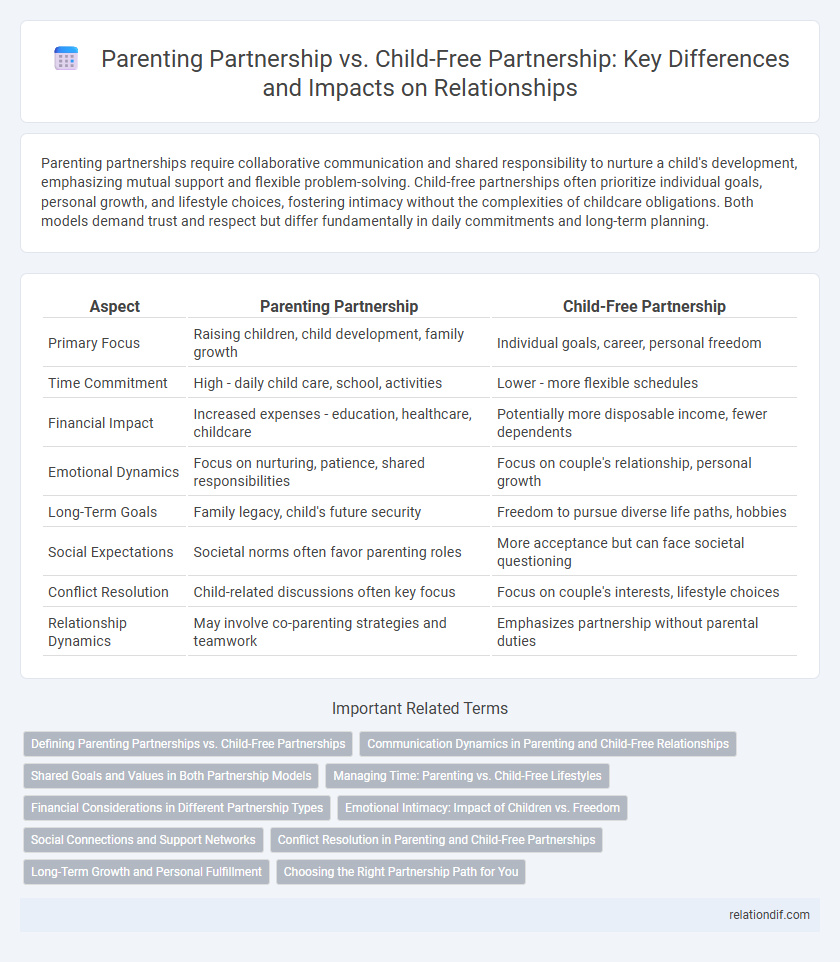Parenting partnerships require collaborative communication and shared responsibility to nurture a child's development, emphasizing mutual support and flexible problem-solving. Child-free partnerships often prioritize individual goals, personal growth, and lifestyle choices, fostering intimacy without the complexities of childcare obligations. Both models demand trust and respect but differ fundamentally in daily commitments and long-term planning.
Table of Comparison
| Aspect | Parenting Partnership | Child-Free Partnership |
|---|---|---|
| Primary Focus | Raising children, child development, family growth | Individual goals, career, personal freedom |
| Time Commitment | High - daily child care, school, activities | Lower - more flexible schedules |
| Financial Impact | Increased expenses - education, healthcare, childcare | Potentially more disposable income, fewer dependents |
| Emotional Dynamics | Focus on nurturing, patience, shared responsibilities | Focus on couple's relationship, personal growth |
| Long-Term Goals | Family legacy, child's future security | Freedom to pursue diverse life paths, hobbies |
| Social Expectations | Societal norms often favor parenting roles | More acceptance but can face societal questioning |
| Conflict Resolution | Child-related discussions often key focus | Focus on couple's interests, lifestyle choices |
| Relationship Dynamics | May involve co-parenting strategies and teamwork | Emphasizes partnership without parental duties |
Defining Parenting Partnerships vs. Child-Free Partnerships
Parenting partnerships center on co-parenting responsibilities, shared decision-making in child-rearing, and mutual support for children's emotional and physical development, emphasizing collaboration and long-term commitment. Child-free partnerships prioritize personal freedom, career growth, and lifestyle choices without the obligations of raising children, often focusing on individual and collective goals unrelated to parenthood. The defining distinction lies in the presence or absence of child-rearing roles, which shapes the partnership's daily dynamics, priorities, and long-term planning.
Communication Dynamics in Parenting and Child-Free Relationships
Parenting partnerships require continual dialogue about child-rearing decisions, schedules, and emotional support to navigate evolving family needs effectively. Child-free partnerships often emphasize communication centered on personal goals, shared interests, and lifestyle choices without the complexities of parenting responsibilities. Both relationship types benefit from clear, empathetic exchanges, but parenting partnerships demand more frequent coordination to maintain household harmony and child well-being.
Shared Goals and Values in Both Partnership Models
Parenting partnerships and child-free partnerships both thrive on clearly defined shared goals and values that guide decision-making and relationship dynamics. In parenting partnerships, mutual commitment to child-rearing principles, education, and emotional support forms a central foundation for collaboration. Child-free partnerships emphasize aligned life aspirations, personal growth, and lifestyle preferences that foster long-term harmony without parenting responsibilities.
Managing Time: Parenting vs. Child-Free Lifestyles
Parenting partnerships require meticulous time management to balance childcare, work responsibilities, and personal life, often involving coordinated schedules and shared household duties. Child-free partnerships enjoy greater flexibility in allocating time toward careers, hobbies, and social activities without the constraints of child-related commitments. Efficient time management strategies differ significantly between these lifestyles, impacting relationship dynamics and individual well-being.
Financial Considerations in Different Partnership Types
Parenting partnerships often face higher expenses due to child-related costs such as education, healthcare, and childcare, impacting household budgeting and long-term financial planning. Child-free partnerships typically experience greater financial flexibility, allowing increased investment in personal goals, savings, and discretionary spending. Understanding these financial dynamics is crucial for partners to align their economic strategies and manage resources effectively.
Emotional Intimacy: Impact of Children vs. Freedom
Parenting partnerships often experience heightened emotional intimacy through shared responsibilities and nurturing roles, fostering a deep connection rooted in mutual support and children's milestones. Child-free partnerships typically enjoy greater freedom, which can enhance emotional bonding via spontaneous experiences and personal growth without the demands of child-rearing. The presence or absence of children significantly shapes the nature and depth of emotional intimacy within partnerships.
Social Connections and Support Networks
Parenting partnerships often cultivate robust social connections through involvement in school communities, playgroups, and family-centered activities, fostering strong support networks essential for child-rearing challenges. Child-free partnerships may experience more diverse social interactions centered on career, hobbies, and travel, maintaining a broader but less child-focused support system. Both partnership types benefit from tailored social networks that enhance emotional well-being and shared lifestyle goals.
Conflict Resolution in Parenting and Child-Free Partnerships
Conflict resolution in parenting partnerships often revolves around child-rearing decisions, discipline strategies, and balancing parental responsibilities, requiring strong communication and compromise skills. In contrast, child-free partnerships typically face conflicts related to lifestyle choices, career goals, and personal freedoms, demanding mutual respect and boundary-setting. Both types of partnerships benefit from open dialogue and empathy to navigate disagreements and maintain relationship harmony.
Long-Term Growth and Personal Fulfillment
Parenting partnerships often foster long-term growth through shared responsibilities and deep emotional bonds, enhancing personal fulfillment by witnessing a child's development and milestones. Child-free partnerships prioritize individual goals and mutual experiences, allowing more flexibility and focus on personal and professional ambitions. Both partnership types require strong communication and commitment to sustain growth and satisfaction over time.
Choosing the Right Partnership Path for You
Choosing the right partnership path involves understanding personal values and lifestyle preferences, whether embracing a parenting partnership or opting for a child-free relationship. Parenting partnerships emphasize shared responsibility, child-rearing goals, and long-term family planning, while child-free partnerships prioritize individual freedom, career focus, and alternative forms of companionship. Assessing compatibility factors such as emotional needs, future aspirations, and mutual respect ensures a fulfilling and sustainable partnership aligned with your unique vision of happiness.
parenting partnership vs child-free partnership Infographic

 relationdif.com
relationdif.com